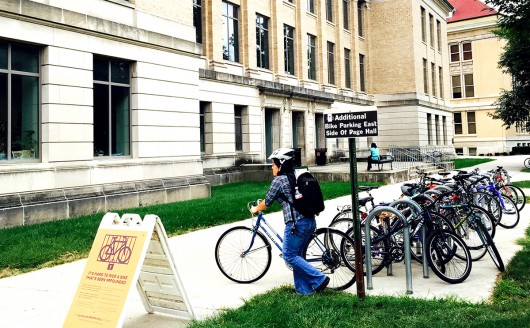
Urban-planning researcher Jennifer Dill said large, young populations — like the one at Ohio State or other universities — are integral to getting populations at large to use bikes as a mode of transportation more often. Credit: Lantern File Photo
Thursday evening, Ohio State’s Center for Urban and Regional Analysis welcomed Jennifer Dill, director of the Transportation Research and Education Center at Portland State University. Dill gave a talk titled “Liveability on Two Wheels,” addressing the contemporary issues that urban planners face when it comes to convincing people to use bikes for transportation in cities.
Attitudes toward biking vary throughout the country, Dill said. While biking can be perfectly accepted in some bike-friendly cities, like Portland, it may not be the case in other places around the country.
“There are a lot of cities in the U.S. where there’s a perception that people bike because they can’t afford a car, or that they had a (citation for drunk driving), and had their driver’s license suspended — that somehow they are forced to bike” Dill said.
There is a gender gap to take into consideration as well. Research shows that, by and large, men tend to be more comfortable on two wheels than women, Dill said.
“Safety is an issue for girls and women,” she said. “They are risk averse compared to men.”
Yet Dill also said this gender gap is not a reality everywhere. In the some European countries, for example, women bike as much as men, and keep biking as their age increases.
Dill described her “recipe” for increasing biking in American cities as if she were preparing a meal:
The protein would be having a well-connected, relatively flat and concentrated environment; the vegetables: a favorable, egalitarian social environment; the secret sauce: attitudes inclined toward cycling; the whole thing would then be served into a bowl, meaning it would be a cheap and easy access to bikes.
Luca Costa and Tyler Hoerst, both fourth-years in environment, economy, development and sustainability, said they found Dill’s talk interesting, and potentially helpful with the work they’re doing in Worthington, Ohio.
“Our initial idea was throwing a bike lane there,” Costa said. “But after having seen this, we have some doubt about (about a bike lane). A bike boulevard seems like a good idea.”
A bike boulevard is an entire road reserved for bicycles, as opposed to a dedicated lane on a road with automobile traffic. With an entire road for cycling, Costa explained, riders might feel safer, and by extension more inclined to ride their bikes.
Sam Schwartz, the urban planner who was the first guest for CURA’s speaker series this semester, emphasized the need for millennials to fight for the healthier lifestyles among American society. Dill did not contradict him.
“All the types of changes that I’m talking about require some political leadership and political will,” she said. “Usually a mayor, or high-level political officials stand up, but advocacy groups are really important as well.”
After spending only a few hours in the Columbus, Dill said she already saw a lot of potential for biking becoming a major mode of transportation — there are protected bike lanes near campus on Summit Street and North Fourth Street, as well as plans to install one just north of campus on Indianola Avenue — and she said that the large, young population of a university like OSU is often a good starting point to make cycling more than a Saturday morning hobby.


